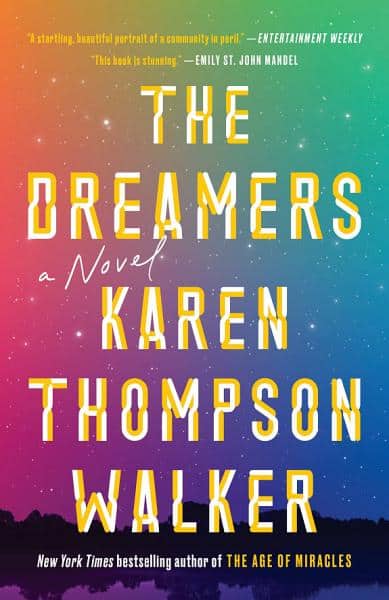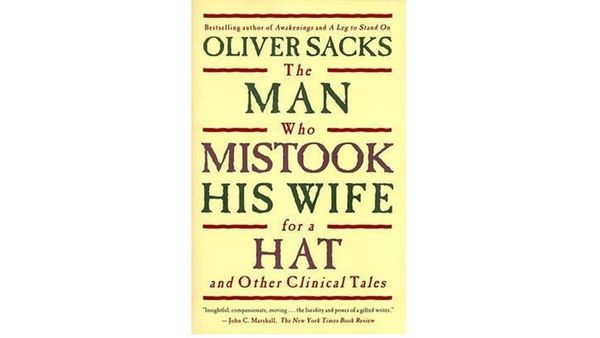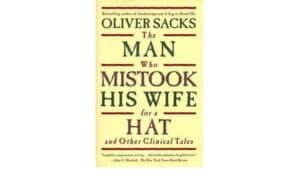
17
Sep
10
SepRemembering Oliver Sacks
 I first discovered Oliver Sacks in college when a science professor assigned the book, The Man Who Mistook His Wife for a Hat. The title comes from a case of a man who did just that – when looking for his hat, he looked at his wife’s head, perceived it somehow as his hat, and put his hands on her head to try to grab it and put it on. This, like so many other stories recounted by Sacks, seems implausible, but if the truth is stranger than fiction, we may also venture to say that the truth of neuroscience is stranger than any other truth we are accustomed to. Oliver Sacks was a British neurologist, practicing in the U.S. for most of his career who wrote prolifically about his patients.
I first discovered Oliver Sacks in college when a science professor assigned the book, The Man Who Mistook His Wife for a Hat. The title comes from a case of a man who did just that – when looking for his hat, he looked at his wife’s head, perceived it somehow as his hat, and put his hands on her head to try to grab it and put it on. This, like so many other stories recounted by Sacks, seems implausible, but if the truth is stranger than fiction, we may also venture to say that the truth of neuroscience is stranger than any other truth we are accustomed to. Oliver Sacks was a British neurologist, practicing in the U.S. for most of his career who wrote prolifically about his patients.
Sacks became well-known for his book Awakenings, which was made into a film starring Robin Williams and Robert De Niro. It was about patients with encephalitis lethargica, better known as sleeping sickness, with whom the Doctor worked at the Beth Abraham Hospital in New York. The patients were unable to move on their own for decades until receiving life-changing treatments with the new drug L-DOPA.
Dr. Sacks went on to write books consisting of case studies and vignettes. The aforementioned Man Who Mistook His Wife for a Hat covers a wide variety of aphasias, amnesias and other disorders. One patient remains essentially “stuck” in 1945, unable to form new memories. He recalls his past in great detail but cannot remember things that just happened or grasp newer developments such as the moon landing or his own gray hair and aging face. The popular movie Memento featured a fictional character with anterograde amnesia, the inability to form new short term memories, but this disorder can truly exist in real life and Sacks wrote of patients with the condition.
The Mind’s Eye offers another collection of case histories including a the story of a musician who loses the ability to read music, followed by the ability to read anything at all, though she can still write perfectly fine and play music by heart. In his books Sacks writes of various patients who have lost the ability to recognize faces, even of their loved ones, and reveals that he himself suffers from some level of prosopagnosia, or face blindness. Some people can only recognize others by memorizing a particular distinctive feature such as a birthmark to look for, or by hearing a person speak or watching them move.
In An Anthropologist on Mars, Sacks provides seven case studies of patients, including one featuring fellow author Temple Grandin. Grandin, who is autistic, has managed to navigate life among the neurotypical. Although she has an impaired ability to recognize social cues, Grandin maintains a deep understanding of animal behavior and has a successful career working with animals and improving their welfare in the ranching and farming industries.
His book Musicophilia specifically addresses music and its relationship with the brain. This could be tragic such as a phenomena of a particular song triggering a seizure, or sometimes beneficial or life enhancing. Sacks describes patients with disorders such as Tourette’s Syndrome and Parkinson’s Disease using music to overcome struggles they face or mitigate their symptoms. He explores how the emotional side of music can help trigger memory and being back some normalcy for people with Dementia.
Rather than gawking at or exploiting patients, Sacks treats them with empathy and fascination, using their stories as windows into a world of adaptability and resilience. Moreover, he does not leave himself unexamined – Sacks wrote prolifically about himself in autobiographies and memoirs including Uncle Tungsten and On the Move. A quick read, Gratitude, serves as a small collection of farewell essays at the end of his life. The world certainly owes Oliver Sacks a debt of gratitude for his lifetime of riveting stories which make science accessible to the layperson and cause us to think deeper about what it means to be human.
Lydia Sampson is the Assistant Director at the Morrill Memorial Library in Norwood, MA. Look for her article in the September 10, 2020 issue of the Transcript and Bulletin.

3
SepMichigan Musings
 Summertime brings with it memories of travelling and visiting family in regions far and near. Every time I get into a hot vehicle and the first blast of warm, muggy air comes out of the car vents, I remember all those sketchy (though money-saving) motels we stayed at while traveling to Michigan in the summer. At least the rooms had air conditioning, unlike the 1977 navy blue Plymouth Volare wagon we traveled in.
Summertime brings with it memories of travelling and visiting family in regions far and near. Every time I get into a hot vehicle and the first blast of warm, muggy air comes out of the car vents, I remember all those sketchy (though money-saving) motels we stayed at while traveling to Michigan in the summer. At least the rooms had air conditioning, unlike the 1977 navy blue Plymouth Volare wagon we traveled in.
Every two years, we would travel out to Michigan to see family. My father had been born a “Michigander,” settling in New England after serving in the Navy from 1958-62. Though I do remember a few trips with both of my parents, it was only after their divorce in 1978 that I recall the details from the many trips to and from “The Great Lakes State.” (And thus the reason for the somewhat seedy motels… my mother would never have agreed to that!) Packing my sister Melissa and my brother Ted and as much luggage and toys as the car would hold, we set off, seatbelt-less and bouncing back and forth from the front to the back, to the “way back.” My father was an incredibly patient man… it would usually take a physical fight between my siblings to get him to raise his voice. The silence was golden!
Traveling out, we usually followed the same route: from New Hampshire to Massachusetts, to New York (and its awful Thruway…bump/ssstssstssst/bump/sssstssstsst/bump for miles!) Skirt around Albany and on to Batavia, New York, which is where we usually stayed the night. Dad normally avoided big cities, giving them names like “Beef-alo” for “Buffalo;” somewhat inexplicably, a place to be avoided (I had yet to understand the issue of traffic flow). We would then head south along Lake Erie, going through Pennsylvania but around Cleveland, Ohio. Then, north along Lake Erie, avoiding Toledo, Ohio, and heading north into Michigan. Then it was just another half an hour until we reached our destination: Mohawk Road in Tecumseh, Michigan, Lenawee County. There was much rejoicing in the station wagon as the long 19-hour journey finally came to an end (bless you, dad!)
After greeting our grandparents, aunts, uncles and cousins, we always wanted to explore… especially any of dad’s old haunts. The River Raisin was a favorite spot… he enjoyed swimming, fishing and just walking along the rocks. This river is about a 5-minute walk from Mohawk Road. I remember one time walking down there and dad stopped, looked, then went over to the side of the path and pointed at something sticking up in the brush. “You kids see that? That is a Christmas tree stand that your Uncle Chub and I made.” We were thrilled to see something that old, and amazed that it was still there! We walked until we came to a spot where there used to be a bridge, but now just the supports were intact. One year, I was stung by nettles as we walked along the water. I couldn’t believe that a plant could “sting.” On another trip, I spent the summer collecting flowers for our pressed flower collection. I picked this pretty, purple flower that turned out to be common blue eyed grass. Poor dad, all the way to and from Michigan that year, I was forever asking him to pull over so I could pick the wildflowers!
We also visited “downtown Tecumseh,” which was a lot smaller back then, and this included a tour of Tecumseh High School, where my dad played football, basketball, did track and wrestled. He might have only been 5′4″ and 130 pounds but he was feisty! In honor of dad’s sporting days, my sister and I usually scored a “Tecumseh Indians” black and orange T-shirt. My brother usually chose a toy. One year, dad took us to the John Deere store located out there and proudly purchased Ted an authentic green and yellow John Deere toy tractor. My brother loved that truck and played with it for many years.
After shopping, it was time to eat. Meals were mostly eaten at grandma and grandpa’s. Grandma made chili (using Campbell’s tomato soup as the base) and lots of hamburgers and hotdogs. One year, dad and his brother Walter (everyone called him Chub), went fishing and brought back a whole slew of bluegill that they caught in Lake Erie. Uncle Chub patiently showed us how to open and gut the fish, and grandma fried them up. Delicious! Served alongside her famous summer marshmallow fruit salad, we felt like we were tasting quintessential Michigan.
When we didn’t eat at the homestead, we had a favorite restaurant that we could only eat at when in Michigan: the Big Boy (dubbed “The Large Fellow” by my Tecumseh cousins) for meals. There are a lot of these restaurants in Michigan, but only a few scattered in just three other states. The Big Boy is an American-style burger joint perfect for families. If we didn’t have dessert there, we would go to get ice cream at what is now G & J’s Frosty Boy, formally just “Frosty Boy.”
At the end of the visit, everyone had to gather to take pictures. This was a more painful process than it is now and one was never sure of the results until the film was developed. My grandmother was in such earnest to get every family group and then the entire family. My father was a master at ruining a good picture. Sometimes grandma would catch him in time (“Carl!”), and sometimes she wouldn’t. There are a series of shots showing dad “gearing up” for the goofy face… it’s almost like time-lapse photography! Needless to say, my brother and my nephew Joey continue on in the tradition. Thankfully, digital cameras now guarantee at least one good picture.
There are a lot of great places to visit in Michigan, such as the Henry Ford Museum and Greenfield Village in Dearborn, and Little Bavaria in Frankenmuth, but don’t dismiss little Tecumseh. Some of my best family memories have been made in that small midwestern town.
For information visit https://tecumsehlibrary.org.
Carla B. Howard is the Senior Circulation and Media & Marketing Assistant at the Morrill Memorial Library in Norwood, MA. Look for her article in the September 3, 2020 issue of the Transcript and Bulletin.

27
AugSummer Fling: Embracing Romance Novels
 Confession time: I’ve never read anything by Nicholas Sparks. I’ve never even seen The Notebook! I’ve never thought of myself as the type of person who reads romances. I’m not sure exactly who I picture as the ideal romance reader but I was certain it was not me. Plus, I’ve always had trouble getting into romance as a genre. I do judge book covers and I’ve never been interested in the classic “bodice-ripper” with a long-haired Fabio-type on the front. My jaded self never considered the more modern romances either, considering those a little too saccharine.
Confession time: I’ve never read anything by Nicholas Sparks. I’ve never even seen The Notebook! I’ve never thought of myself as the type of person who reads romances. I’m not sure exactly who I picture as the ideal romance reader but I was certain it was not me. Plus, I’ve always had trouble getting into romance as a genre. I do judge book covers and I’ve never been interested in the classic “bodice-ripper” with a long-haired Fabio-type on the front. My jaded self never considered the more modern romances either, considering those a little too saccharine.
During the COVID-19 pandemic, I have observed that people take one of two routes in order to deal with current events. Some folks dive head first into books or movies with themes that match what is happening in our world. Several people I know took this even further by doing research on other pandemics like the 1918 Spanish Flu pandemic or the polio scares in the late 1940s. For some, learning as much as possible seems to be a route to comfort.
Others take the escapist route and look for lighter fare. I have heard so many people say they have had trouble enjoying their usual artistic tastes, especially if they generally gravitate toward books or movies with heavier themes and topics. Some other readers have confessed that it was difficult to even focus on any type of reading during this spring’s quarantine period.
A coworker with similar taste in books was recently corresponding with me over our latest reads. Although I shouldn’t have been, I found myself shocked to learn that she had been exclusively reading romance novels ever since March. She admitted to being just as surprised as I was regarding her foray into this genre since she never thought of herself as a “romance reader.” But like many folks, she found she wanted an escape from everyday life when she picked up a book rather than untangling complicated plots or contemplating anything depressing.
I was intrigued. Why did I have such a distaste for romance novels? What’s wrong with a little escapism? Nothing, I decided. Once my coworker sent some recommendations for titles to try, my long-term relationships with fantasy and literary fiction were on hold. I was off on a summer fling with romance and I threw myself into it.
First, I started my journey with Jasmine Guillory, author of modern romances that feature strong female characters who are independent but looking for an equal partner. Guillory’s modern sensibility also means focusing on people of color as main characters and including interracial relationships in her stories. In The Wedding Date, Guillory artfully starts with the rather silly premise of two people getting stuck in an elevator and develops a realistic long-distance relationship between Alexa, an ambitious political operative in San Francisco, and Drew, an LA-based pediatrician. Drew and Alexa move from pretending they are together at a wedding into a steamy relationship that navigates distance, race, and when to get serious. Guillory penned several more novels in the “Wedding Date” series although they feature other couples from Drew and Alexa’s social circle.
My second recommendation features romance with a historical twist: In Bringing Down the Duke by Evie Dunmore, Annabelle Archer earns a scholarship at Oxford in exchange for supporting the women’s suffrage movement in Victorian England. She ends up advocating for her cause to conservative Duke of Montgomery, an influential aristocrat who is tasked with stopping the cause’s progression in Parliament by the Queen. This novel exhibits the more traditional features of a classic romance novel, albeit one with a strong willed heroine dedicated to a feminist cause. Annabelle refuses to give up on her dreams in spite of the limitations society tries to place. If you enjoyed the frustrated banter between Lizzie and Mr. Darcy in Pride and Prejudice but are looking for something bit more spicy, this one’s for you.
Kevin Kwan’s debut series Crazy Rich Asians and subsequent film really put romantic comedies back on the map. Kwan tried to recreate the fast-paced, gossipy style and hilarious name-dropping footnotes that skyrocketed Crazy Rich Asians to instant success with his latest novel, Sex and Vanity. The final result is an uneven, overlong attempt to modernize E.M. Forster’s A Room with A View, a novel about a woman torn between two worlds, into a comedy of manners. This book was a bit too long and the style Kwan employs in his other work just didn’t translate well here. Kwan reimagines Lucie Churchill as a biracial art dealer from New York who is torn between two cultures while trying not to fall in love with the enigmatic George Zao. He thoughtfully illustrates the effects of the Churchill family’s explicit racism regarding Lucy’s Chinese heritage and her ensuing identity crisis, which is the novel’s highlight. I’m hoping his future works play into his strengths as a comic author and that he continues creating fresh stories instead of retreading ones from the past.
My final summer romance is the aptly titled Beach Read by Emily Henry. Be warned; there is nothing beach-y about this novel. Set on the shores of Lake Michigan, a writer of romance novels takes up residence in her father’s love nest after his untimely death and the revelation of his extramarital affair. January Andrews’ world is unraveling: her crippling depression prevents her from writing, she’s out of money, and her long-time boyfriend leaves her now that she’s not the upbeat person she once was. Her new neighbor is Augustus Everett, literary fiction writer and her old college nemesis. The two couldn’t be more opposite but end up challenging each other to write a novel in the other’s style. Old rivalries, insecurities and attraction flare as January attempts to teach Gus the tropes of the romance novel while they both research a local cult. This book has fully realized characters who enter into a believable relationship, making this title the best of the bunch.
Romance may never be my preferred genre but I’m happy I gave it a shot this summer. I can definitely see myself looking for more off-beat romance titles when I need a change of pace from my genres of choice. It’s a great reminder that we all need to stretch our reading muscles and try something new!
Kate Tigue is the Head of Youth Services at the Morrill Memorial Library in Norwood, MA. Look for her article in the August 27, 2020 issue of the Transcript and Bulletin.


 My stove died. Right in the middle of baking cookies with my daughter. Of course, it’s 2020. What can I expect? It’s been such a challenging year that a small inconvenience like having no stove or oven didn’t really phase me and I sighed as I called the service department of the appliance store where I purchased this stove less than a year ago. The technician couldn’t come to my house for a few days and, adding on time for parts and repair work, I estimated I’d be sans stove for about 10 days.
My stove died. Right in the middle of baking cookies with my daughter. Of course, it’s 2020. What can I expect? It’s been such a challenging year that a small inconvenience like having no stove or oven didn’t really phase me and I sighed as I called the service department of the appliance store where I purchased this stove less than a year ago. The technician couldn’t come to my house for a few days and, adding on time for parts and repair work, I estimated I’d be sans stove for about 10 days. After the library closed in mid-March due to the Coronavirus, and when we were still in some disbelief of what was happening to life as we knew it, I immediately reached for my copy of
After the library closed in mid-March due to the Coronavirus, and when we were still in some disbelief of what was happening to life as we knew it, I immediately reached for my copy of